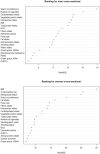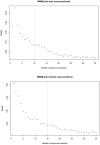Past or Present; Which Exposures Predict Metabolomic Aging Better? The Doetinchem Cohort Study
- PMID: 37642222
- PMCID: PMC10799759
- DOI: 10.1093/gerona/glad202
Past or Present; Which Exposures Predict Metabolomic Aging Better? The Doetinchem Cohort Study
Abstract
People age differently. Differences in aging might be reflected by metabolites, also known as metabolomic aging. Predicting metabolomic aging is of interest in public health research. However, the added value of longitudinal over cross-sectional predictors of metabolomic aging is unknown. We studied exposome-related exposures as potential predictors of metabolomic aging, both cross-sectionally and longitudinally in men and women. We used data from 4 459 participants, aged 36-75 of Round 4 (2003-2008) of the long-running Doetinchem Cohort Study (DCS). Metabolomic age was calculated with the MetaboHealth algorithm. Cross-sectional exposures were demographic, biological, lifestyle, and environmental at Round 4. Longitudinal exposures were based on the average exposure over 15 years (Round 1 [1987-1991] to 4), and trend in these exposure over time. Random Forest was performed to identify model performance and important predictors. Prediction performances were similar for cross-sectional and longitudinal exposures in both men (R2 6.8 and 5.8, respectively) and women (R2 14.8 and 14.4, respectively). Biological and diet exposures were most predictive for metabolomic aging in both men and women. Other important predictors were smoking behavior for men and contraceptive use and menopausal status for women. Taking into account history of exposure levels (longitudinal) had no added value over cross-sectionally measured exposures in predicting metabolomic aging in the current study. However, the prediction performances of both models were rather low. The most important predictors for metabolomic aging were from the biological and lifestyle domain and differed slightly between men and women.
Keywords: Exposome; Human aging; Metabolomics; Sex differences.
© The Author(s) 2023. Published by Oxford University Press on behalf of The Gerontological Society of America.
Conflict of interest statement
None.
Figures


Similar articles
-
Association between metabolomics-based biomarker scores and 10-year cognitive decline in men and women. The Doetinchem Cohort Study.Age Ageing. 2024 Nov 4;53(11):afae256. doi: 10.1093/ageing/afae256. Age Ageing. 2024. PMID: 39558869 Free PMC article.
-
Lifestyle factors and metabolomic aging biomarkers: Meta-analysis of cross-sectional and longitudinal associations in three prospective cohorts.Mech Ageing Dev. 2024 Aug;220:111958. doi: 10.1016/j.mad.2024.111958. Epub 2024 Jun 29. Mech Ageing Dev. 2024. PMID: 38950629
-
Predictors of healthy physiological aging across generations in a 30-year population-based cohort study: the Doetinchem Cohort Study.BMC Geriatr. 2023 Feb 23;23(1):107. doi: 10.1186/s12877-023-03789-2. BMC Geriatr. 2023. PMID: 36823523 Free PMC article.
-
Robust Metabolomic Age Prediction Based on a Wide Selection of Metabolites.J Gerontol A Biol Sci Med Sci. 2025 Feb 10;80(3):glae280. doi: 10.1093/gerona/glae280. J Gerontol A Biol Sci Med Sci. 2025. PMID: 39821408 Free PMC article.
-
Using random forest to identify longitudinal predictors of health in a 30-year cohort study.Sci Rep. 2022 Jun 20;12(1):10372. doi: 10.1038/s41598-022-14632-w. Sci Rep. 2022. PMID: 35725920 Free PMC article.
Cited by
-
Advanced Glycation End-Products and Metabolomics Are Independently Associated With Frailty: The Longitudinal Doetinchem Cohort Study.J Gerontol A Biol Sci Med Sci. 2025 May 5;80(6):glae272. doi: 10.1093/gerona/glae272. J Gerontol A Biol Sci Med Sci. 2025. PMID: 39607723 Free PMC article.
-
Associations Between Leisure-Time Physical Activity and Metabolomics-Based Markers of Biological Aging in Late Midlife: Short-Term and Long-Term Follow-Up.Aging Cell. 2025 Jun;24(6):e70033. doi: 10.1111/acel.70033. Epub 2025 Mar 10. Aging Cell. 2025. PMID: 40063409 Free PMC article.
References
-
- World Health Organization. World Report on Ageing and Health. Geneva, Switzerland: World Health Organization; 2015.
Publication types
MeSH terms
Grants and funding
LinkOut - more resources
Full Text Sources
Medical
Miscellaneous

